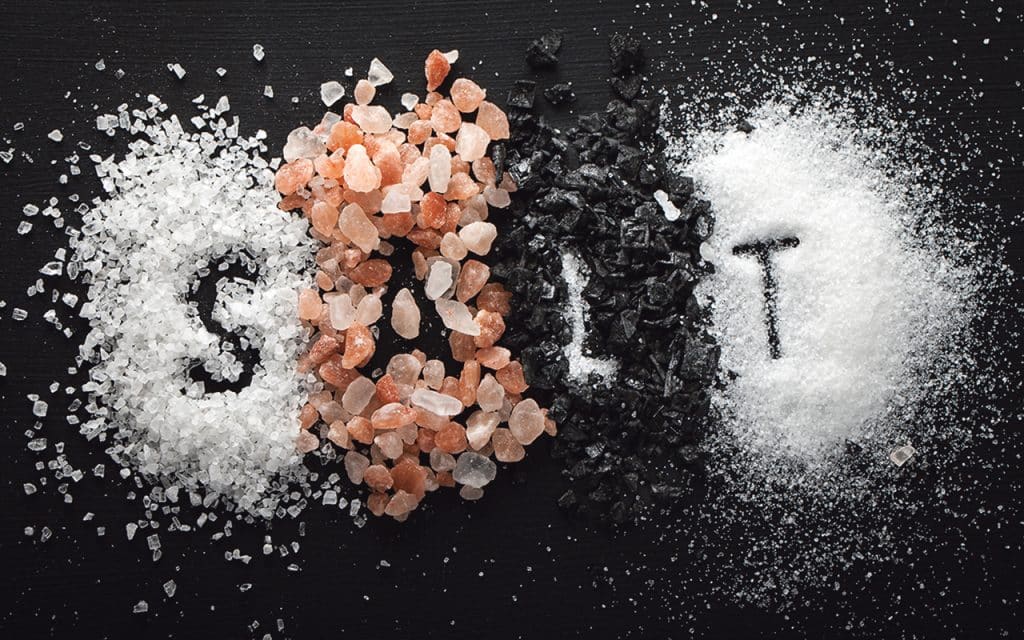
This month, I’ve gone deep into the world of salt — its history, where we source it, how it has shaped civilisations, and, of course, which are the best salts to use in our kitchen!
Salt has influenced human civilisation for thousands of years, shaping trade, economies, and even wars. Ancient cultures – from the Egyptians to the Romans – relied on it for preserving food and enhancing flavour. It was once so valuable that Roman soldiers were paid in ‘salarium’ (the root of the word ‘salary’). Salt routes and monopolies fuelled empires, and at times, access to salt determined the fate of nations. From medieval salt taxes to Gandhi’s Salt March, this humble mineral has played a surprisingly powerful role in history.
Salt is everywhere – it’s found in seawater, underground deposits, and salt flats. Oceans hold the largest supply, with about 35 grams of dissolved salt per litre. Underground salt deposits, formed from ancient evaporated seas, are mined in places like the US, Canada, China, and Germany. Salt flats – like Bolivia’s Salar de Uyuni and Utah’s Bonneville Salt Flats – form when saltwater lakes evaporate, leaving behind vast crusts of salt. Even Mars has traces of salt, hinting at the presence of ancient water!
Salt has seasoned our language as much as our food. Ever heard the phrase “not worth his salt”? It dates back to ancient Rome when soldiers were sometimes paid in salt. “The salt of the earth” (from the Bible) describes someone honest and reliable. “Take it with a grain of salt” suggests skepticism – possibly from the idea that a little salt makes something easier to swallow. Across cultures, salt has flavoured not just meals, but the way we speak.
We all know that too much salt can be harmful, but sodium is still an essential mineral. The key is choosing the right kind of salt and consuming it in moderation, and being aware of all the ‘hidden salts’ in our foods.
If you’re trying to be mindful of your salt intake, the main foods to keep an eye on are ultra-processed foods, which can contain shockingly high levels of refined salt.
High-Sodium Foods include bread – supermarket sliced bread, baguettes, crispbreads; processed meats – salami, bacon, ham, sausages; salty snacks – crisps, French fries, crackers, salted nuts; and cheese – brie, cheddar, mozzarella; soups – tinned, frozen or powdered.
While salt is essential for bodily functions, most people consume far more than they need. The recommended daily intake for adults is around 5g (one teaspoon IN TOTAL), yet processed foods can easily push us beyond this limit.
Signs of excessive salt intake include: Frequent thirst and dehydration; swollen hands, feet, or face (water retention); high blood pressure, which can lead to long-term cardiovascular issues; headaches and a feeling of sluggishness after salty meals.
One simple way to monitor your intake is by checking food labels – salt content is often listed as ‘sodium’, and 1g of sodium equals about 2.5g of salt. Cooking from scratch and opting for fresh, unprocessed foods can really help keep your levels in check.
I once saw a documentary about a shop in Japan which sold over 300 different types of salt That seems a little excessive, but I do like to have a variety of salts in my kitchen (and some others in my bathroom!)
In Organico, like many Healthfood Shops, you’ll find a wide range of different salts (though you won’t usually find table salt, as we don’t rate it either for flavour or health)
We stock: Regular Sea Salt (coarse and fine); Celtic salt/French seasalt/grey salt; pink Himalayan salt; herbal salt (we love Herbamare by A.Vogel); Irish salts – like Atlantic Salt from the Beara, Achill Island salt; flavoured salts – smoked, seaweed salt; Maldon salt (flakey, great for finishing dishes).
Not all salts are created equal however! While they all share sodium chloride as their base, their sources, mineral content, and processing methods vary greatly:
Table salt: The most common, highly refined salt. It’s stripped of minerals and often contains additives like anti-caking agents and iodine. It’s the type of salt most commonly found in ultra processed foods and is often responsible for contributing too much salt in our diet.
Sea salt: Harvested from evaporated seawater, sea salt retains trace minerals like magnesium and calcium, which contribute to its flavour and potential health benefits. The texture and taste vary depending on the source, with options ranging from fine to coarse grains.
Celtic salt: A specific type of sea salt from the coastal regions of France, Celtic salt is unrefined, naturally grey in colour, and retains moisture. It’s packed with over 80 trace minerals, making it a great choice for those looking to boost electrolyte balance.
Himalayan salt: Mined from ancient sea beds in the Himalayas, this pink-hued salt is rich in minerals like iron, potassium, and magnesium. It’s less processed than table salt.
Each type of salt has its place, and choosing the right one depends on your dietary goals, taste preferences, and cooking needs.
Sea salt is best for everyday cooking (I prefer the French grey salt) and Himalayan salt offer great flavour while providing trace minerals. Use fine sea salt for general cooking and baking, and coarser salts (or a flakey salt like Maldon on Irish Atlantic Salt) for seasoning dishes just before serving.
Celtic/French Sea Salt is a good choice for those seeking a mineral-rich, unrefined option.
For fermentation and curing, coarse sea salt, French Salt or Himalayan salt all work well, as they don’t contain additives that might interfere with fermentation.
Ultimately, moderation is key—choosing a quality salt is important, but reducing processed foods is even more effective in managing sodium intake.
Salt also has many therapeutic uses ranging from helping with conditions like asthma, COPD, and inflammation through salt caves and halotherapy to increasing magnesium levels and easing muscle tension (Epsom Salts). My personal favourite are salt float tanks. Filled with high levels of magnesium salts, they allow you to float effortlessly, helping to relax the nervous system. I love visiting the Zero Gravity float tanks in Cork.
Adding sea salt to your bath can help with skin conditions like eczema and psoriasis, as well as soothe sore muscles after a workout – I use coarse Celtic salt for this – and gargling salt water or using a saline rinse can be great for sinus health and soothing a sore throat.
Salt is so much more than just a kitchen staple so whether you’re enjoying a salt float, using a salt scrub, or simply sprinkling the right kind of salt on your food, it’s worth taking some time to appreciate this humble yet essential mineral.
If you want to stock up on salt, come and visit! We’re open in Bantry from 9am-6 pm, Monday to Saturday, with our Deli serving coffee and lunch from 9am-4 pm. If you can’t visit in person, our online shop is shipping across all 32 counties at www.organico.ie.



